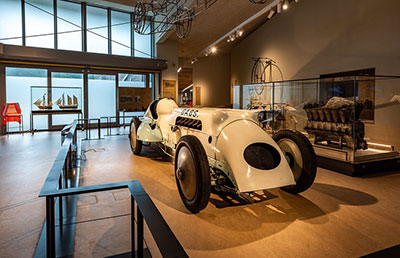The Pendine Museum of Land Speed on the South Wales coast offers a series of classic A/V presentations based on historical themes in extreme motor sports, emphasising the dramatic sights and sounds of hugely powerful and highly tuned racing vehicles, and allowing visitors to witness the sheer exhilaration of extraordinary high-speed record achievements set against the backdrop of a seven-mile stretch of Pendine Sands.
The soundtracks that accompany wide-screen videos are supported by K-array’s smallest line array speakers, coupled with compact stand-alone subwoofers.
One of the principal challenges for New Forest-based A/V systems integrator DJ Willrich was that the museum required that they provide a stereo image for each of the super-wide wall-mounted video screens, and blend in with the structures of the exhibits – without being at all obtrusive or detract in any way from the visuals which dictate the historical ambience of the space – but just reinforce the video content, and in a big way. Furthermore, the brief also called for the loudspeakers not to be seen at all.
 ‘Many of our museum clients typically prefer more streamlined A/V technology around their exhibits,’ says DJ Willrich Director, Josh Miller. ‘That’s why the K-array speakers work so well in this environment – they are completely invisible, and yet the coverage is excellent and they sound huge.’
‘Many of our museum clients typically prefer more streamlined A/V technology around their exhibits,’ says DJ Willrich Director, Josh Miller. ‘That’s why the K-array speakers work so well in this environment – they are completely invisible, and yet the coverage is excellent and they sound huge.’
DJW set ultra-micro Lyzard-KZ14 line arrays behind the fascias of the exhibits, so that it’s not immediately obvious exactly where the sounds that accompany the footage of the feats of John Parry-Thomas’ V-12 aero engine-powered car ‘Babs’ and its successors are coming from – the only clue as to their location being the pair of subtle horizontal slots machined out of the continuous Corian exhibit housings. The horizontal orientation of the 100mm-long line arrays results in a fairly wide 140° vertical coverage pattern that caters very well for a range in height of visitors from children to adults, while the 40° horizontal dispersion effectively avoids overspill of sound between adjacent exhibits.
The omni-directional output from the Truffle-KTR25 subwoofers concealed within the exhibits (and equipped with a pair of 5.25-inch low frequency drivers) in a cylindrical aluminium housing designed to remain hidden from view, reaches down to 45Hz and emanates from horizontal reveals at the bottom of the exhibits, bringing to life the pulsating rhythms of high-speed engines and deep bass impact necessary to evoke the true essence of high-speed racing and raw engine power.
Each of the individual audio systems is powered by a Kommander-KA02 compact four-channel class-D amplifier connected directly to the dedicated HD video player and configured by onboard DSP to drive both the small line arrays and the subwoofer for each exhibit. This results in absolutely minimal cable runs and easy control and automation of the content via a centralised control PC running Showmaster software.
The quality of the audio delivery has made an impression on visitors, according to Commercial Operations Manager Andrew Sellick: ‘The museum’s only been open since the end of May, and remarkably for this relatively out of the way part of South Wales we’ve already seen around 5,000 visitors – that’s over 150 a day. They’re clearly impressed with the clarity and range of the soundtracks and how well they convey the visceral excitement of these extraordinary high-speed achievements.
‘In terms of after sales support from DJW, it’s been superb. They always answer the phone, and any technical issues that we may have are resolved straight away. And even at weekends I’ve sent email on a Saturday night and got a reply first thing Monday morning at half past eight, which is fantastic.’

